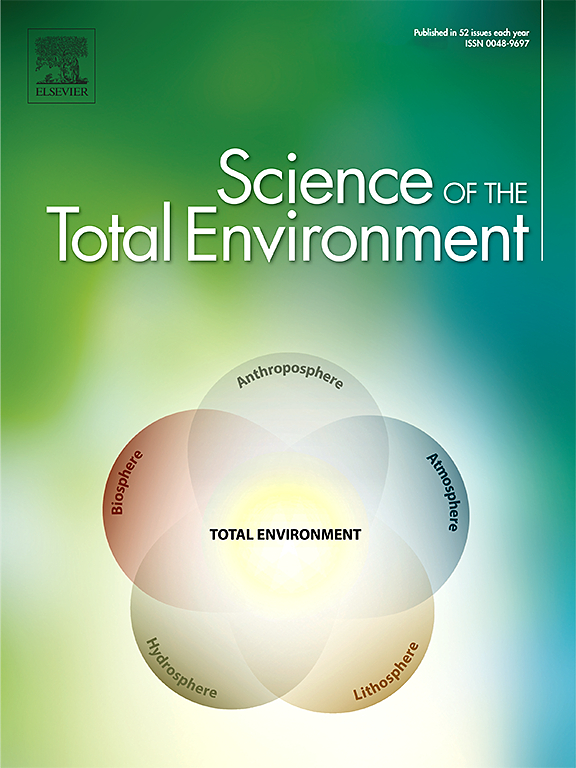Influence of ferulic acid and active rice straw extract on the composting behaviour of PHBV and PHBV/PCL blend films
IF 8.2
1区 环境科学与生态学
Q1 ENVIRONMENTAL SCIENCES
引用次数: 0
Abstract
The biodegradation of polymer films is affected both by their composition and structure and by the environmental conditions. Composting behaviour of poly(hydroxybutyrate-co-hydroxyvalerate) (PHBV) films was studied at lab-scale, according to ISO 20200:2023, as affected by its blend (1:1) with polycaprolactone (PCL), and the presence (6 % wt.) of active compounds (Ferulic acid: FA, and rice straw extract: RSE). The film disintegration (mass loss) was monitored over the composting time, by microstructural analysis, FTIR spectroscopy, and thermal analyses. All films disintegrated completely at the end of the test (84 days), but the disintegration rate was affected by the formulation. PHBV and blends films containing RSE exhibited the fastest disintegration whereas blend films without actives were the slowest. In every case, the surface erosion provoked by the biofilm action was the main mechanism responsible for the film thinning, but bulk hydrolysis also occurred to a different extent. RSE, with high content of carbohydrates, promoted the film porosity and bulk hydrolysis of both PHBV and its blend with PCL where the crystallinity of PCL was promoted. FA also accelerated the hydrolysis of the PHBV amorphous phase as well as the crystalline phases of PCL, as deduced from DSC analysis. Therefore, degradation rate was affected by overlapping of the different mechanism, depending on the film composition and structure. Promoting the water diffusion through the film favoured the hydrolytic processes and the enzymatic action of the biofilm microorganisms, whose population and activity could also be affected by film components.

阿魏酸和活性稻草提取物对PHBV和PHBV/PCL共混膜堆肥行为的影响
聚合物膜的生物降解既受其组成和结构的影响,也受环境条件的影响。根据ISO 2020:2023,在实验室规模上研究了聚(羟基丁酸酯-共羟戊酸酯)(PHBV)薄膜的堆肥行为,受其与聚己内酯(PCL)(1:1)的混合物以及活性化合物(阿魏酸:FA和稻草提取物:RSE)的存在(6% wt.)的影响。通过微观结构分析、红外光谱分析和热分析,监测了堆肥过程中膜的分解(质量损失)。试验结束(84 d),所有薄膜均完全崩解,但崩解速率受配方影响。含RSE的PHBV和共混膜崩解速度最快,无活性的共混膜崩解速度最慢。在每种情况下,生物膜作用引起的表面侵蚀是导致膜变薄的主要机制,但也有不同程度的体水解发生。高碳水化合物含量的RSE促进了PHBV及其与PCL共混物的膜孔隙度和体水解,从而提高了PCL的结晶度。从DSC分析推断,FA也加速了PHBV非晶相和PCL结晶相的水解。因此,降解速率受不同机制重叠的影响,取决于膜的组成和结构。促进水在膜中的扩散有利于生物膜微生物的水解过程和酶促作用,其数量和活性也会受到膜成分的影响。
本文章由计算机程序翻译,如有差异,请以英文原文为准。
求助全文
约1分钟内获得全文
求助全文
来源期刊

Science of the Total Environment
环境科学-环境科学
CiteScore
17.60
自引率
10.20%
发文量
8726
审稿时长
2.4 months
期刊介绍:
The Science of the Total Environment is an international journal dedicated to scientific research on the environment and its interaction with humanity. It covers a wide range of disciplines and seeks to publish innovative, hypothesis-driven, and impactful research that explores the entire environment, including the atmosphere, lithosphere, hydrosphere, biosphere, and anthroposphere.
The journal's updated Aims & Scope emphasizes the importance of interdisciplinary environmental research with broad impact. Priority is given to studies that advance fundamental understanding and explore the interconnectedness of multiple environmental spheres. Field studies are preferred, while laboratory experiments must demonstrate significant methodological advancements or mechanistic insights with direct relevance to the environment.
 求助内容:
求助内容: 应助结果提醒方式:
应助结果提醒方式:


